At some point in their fitness journey, most gymgoers ask, “How do I get a 6 pack?”
After all, many view washboard abs as the hallmark of the fitness elite—the proof that you know the “secrets” of getting ripped.
And, like anything that’s highly sought after, there’s a long list of charlatans offering up spurious advice on how to snag this brass ring. Case in point:
- Some people say you have to do special types of ab exercises . . . and they’re wrong.
- Some people say you just have to get lean . . . and they’re wrong.
- Some people say you just have to do a lot of heavy squats and deadlifts . . . and they’re wrong.
- Some people say you have to avoid certain types of foods and take weird supplements . . . and they’re really wrong.
In reality, the best way to get abs involves combining several of these strategies. Specifically, reducing your body fat percentage, doing the right types of weightlifting and ab exercises, and eating enough protein.
And in this article, you’ll learn exactly what you need to know to implement all of these steps properly.
How to Actually Get Abs
Despite what most people say, the best way to get a 6 pack is actually pretty simple.
In fact, it mostly comes down to the following three things:
1. Reduce your body fat percentage.
No matter how well developed your core muscles are, they’ll never “pop” if they’re covered by too much fat. Thus, reducing your body fat percentage (below ~12% for guys and ~22% for girls) is the best way to get abs to stand out.
Crucially, you can’t “spot reduce” your belly fat by doing ab exercises. Exercising a muscle group causes your body to burn fat around it, but the effect is too insignificant to change your appearance.
Instead, drive fat loss through proper dieting, strength training, and cardio.
2. Do the right ab exercises.
To get a well-developed six pack, you need to include two types of exercises in your training:
- Compound exercises: Performing compound exercises, such as the squat, deadlift, bench and overhead press, trains your core better than many traditional ab exercises (and especially when you lift heavy loads).
- Ab and core exercises that you can overload: Doing some targeted ab exercises helps you build ab size and core strength. There are thousands of ab exercises to choose from, but most are ineffective. The best ab exercises allow you to safely train and overload all of your core muscles, and don’t require much in the way of technical skill, flexibility, or athleticism (more on the specifics soon).
3. Eat enough protein
High-protein dieting beats low-protein in every way, especially when you’re dieting to lower your body fat percentage.
While trying to build abs, you should eat around 1 gram of protein per pound of body weight per day.
And if you’re very overweight (25%+ body fat in men and 30%+ in women), reduce this to around 40% of your total calories per day.
The Best Ab and Core Exercises for Building a 6 Pack
1. Cable Crunch
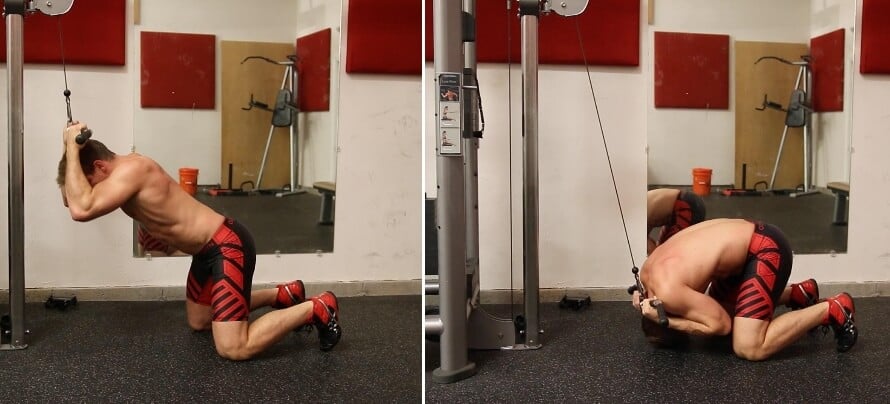
Why: The cable crunch trains your abs through a full range of motion and allows you to progressively overload your entire core, making it a highly effective ab exercise.
How to:
- Set the pulley on a cable machine to a high setting and connect the rope attachment.
- Grab one end of the rope in each hand and kneel down 2-to-3 feet in front of the cable machine, pulling the rope down with you so that the ends of the rope are next to your ears.
- Lean forward slightly, and using your abs, pull your elbows towards your knees.
- Reverse the movement and return to the starting position.
2. Weighted Sit-up
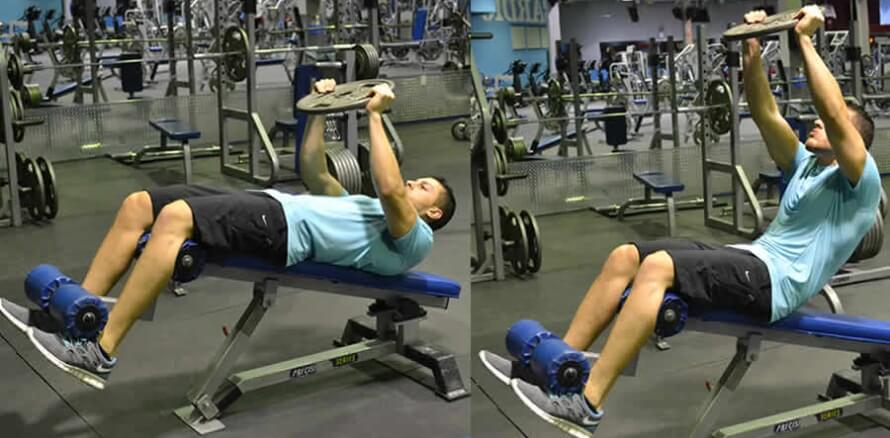
Why: Like the cable crunch, the weighted sit-up allows you to progressively overload your abs, making it well-suited for gaining muscle and strength.
How to:
- Lie on a sit-up bench with your feet wedged under the foot pads.
- Using both hands, hold a weight plate directly above your chest with your arms straight (or hold the weight against your chest with your arms crossed).
- Keeping your arms perpendicular to the floor and your back flat, use your ab muscles to lift your chest toward the ceiling until your lower back comes off the bench.
- Reverse the movement and return to the starting position.
3. Captain’s Chair Leg Raise
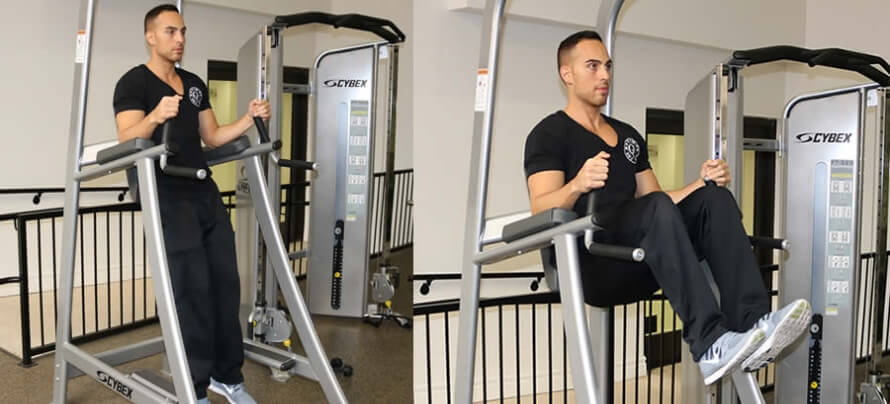
Why: Research shows that exercises that involve bringing the pelvis toward the chest, such as the captain’s chair leg raise, are best for training the lower abs, which is important if you want to build an aesthetic six-pack.
How to:
- Position yourself in a captain’s chair station so your back is resting against the back pad and your forearms are resting on the arms pads
- Grab the handles and let your feet hang toward the floor.
- Lift your feet toward the ceiling, keeping your legs as straight as possible and your back pressed against the pad.
- Once your legs are slightly above parallel to the floor, reverse the movement and return to the starting position.
Tip: If you aren’t strong enough to do the exercise with straight legs, perform it by bringing your knees upward first, so that your thighs are parallel to the floor. As you get stronger over time, work toward performing the exercise with straight legs.
4. Hanging Leg Raise
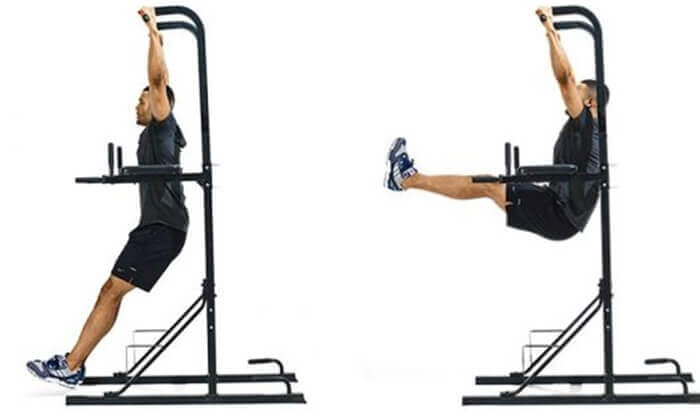
Why: Like the captain’s chair leg raise, the hanging leg raise is a great way to train your lower abs. In this case, your entire core has to stabilize your body and prevent it from swinging, making it an outstanding exercise for training your abs and developing a strong core.
How to:
- Grip a pull-up bar with your palms facing away from you and slightly wider than shoulder-width apart, then lift up your feet so that you’re hanging with your arms straight.
- Lift your feet toward the ceiling, keeping your legs as straight as possible and without swinging your feet or knees.
- Lift your feet as high as you can, aiming to get your legs slightly above parallel to the floor.
- Reverse the movement and return to the starting position.
Tip: If you aren’t strong enough to do the exercise with straight legs, perform it by bringing your knees upward first, so that your thighs are parallel to the floor. As you get stronger over time, work toward performing the exercise with straight legs.
5. Air Bicycle
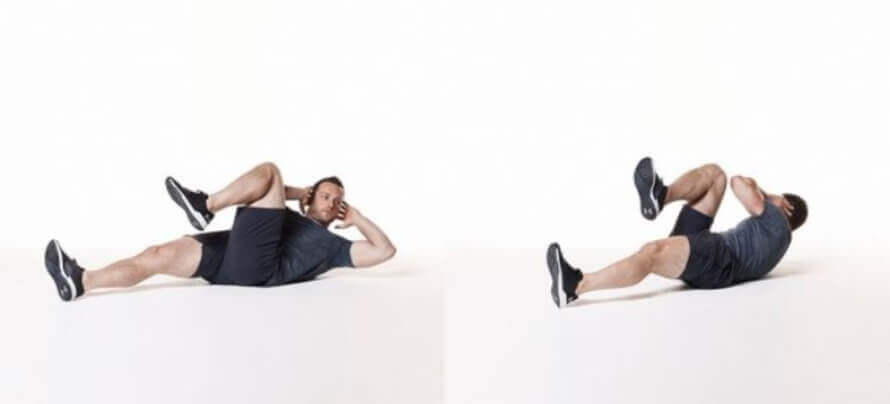
Why: Research shows that the air bicycle is a fantastic exercise for training your obliques, which are the muscles that lie under your “love handles” and help frame your abs.
How to:
- Lie on the floor with your legs straight and your feet raised a few inches off the floor.
- Place your hands beside your ears and lightly touch your head with your finger tips.
- Using your ab muscles, lift your chest off the floor and bring your left knee toward your head. At the same time, bring your right elbow to meet your left knee.
- Reverse the movement and return to the starting position, then repeat on the opposite side.
6. Ab Wheel Rollout

Why: Studies show that the ab wheel rollout is an extremely effective exercise for training all parts of the abs and core, especially the rectus abdominis and the obliques.
How to:
- Kneel down on the floor with an ab wheel in front of you.
- With your arms fully extended, core braced, and back flat, grab the handles of the ab wheel and slowly roll the wheel away from you.
- Roll the wheel until your body is as close to parallel with the floor as possible then roll yourself back to the starting position by flexing your abs.
Tip: start with your knees and feet in contact with the floor, but as you get stronger you can cross your feet and lift them off the floor a few inches to make the exercise more difficult.
How to Get a 6 Pack: FAQs
FAQ #1: How long does it take to get a 6 pack?
For an accurate estimate of how long it’ll take to get abs based on your body fat percentage, take a look at this table:

And for more information, check out this article:
How Long Does It Take to Get Six-Pack Abs?
FAQ #2: How can I make my abs more defined?
To get defined abs, do the following:
- Follow a calorie-controlled, healthy diet to lower your body fat percentage to below ~12% for men or ~22% for women
- Follow a well-designed strength training program that includes lots of compound weightlifting
- Do ab exercises that train your entire core and allow you to progressively overload your abs
FAQ #3: Do planks give you abs?
Planks train your abs, but doing planks alone won’t help you get visible abs. Building abs requires you to lower your body fat percentage to below ~12% for men and ~22% for women, then training your abs with a range of compound and isolation exercises.
If you’re particularly fond of planks, you could incorporate them into your routine, but there are more effective ab exercises, such as the cable crunch, weighted sit-up, captain’s chair leg raise, hanging leg raise, air bicycle, and ab wheel rollout.
Scientific References +
- Vispute, Sachin S, et al. “The Effect of Abdominal Exercise on Abdominal Fat.” Journal of Strength and Conditioning Research, vol. 25, no. 9, Sept. 2011, pp. 2559–2564, journals.lww.com/nsca-jscr/Pages/articleviewer.aspx?year=2011&issue=09000&article=00027&type=Fulltext, https://doi.org/10.1519/jsc.0b013e3181fb4a46.
- Stallknecht, Bente, et al. “Are Blood Flow and Lipolysis in Subcutaneous Adipose Tissue Influenced by Contractions in Adjacent Muscles in Humans?” American Journal of Physiology-Endocrinology and Metabolism, vol. 292, no. 2, Feb. 2007, pp. E394–E399, https://doi.org/10.1152/ajpendo.00215.2006.
- Nuzzo, James L, et al. “Trunk Muscle Activity during Stability Ball and Free Weight Exercises.” Journal of Strength and Conditioning Research, vol. 22, no. 1, 2008, pp. 95–102, www.ncbi.nlm.nih.gov/pubmed/18296961, https://doi.org/10.1519/JSC.0b013e31815ef8cd. Accessed 1 Nov. 2019.
- Moraes, Antonio C., et al. “EMG Activation of Abdominal Muscles in the Crunch Exercise Performed with Different External Loads.” Physical Therapy in Sport: Official Journal of the Association of Chartered Physiotherapists in Sports Medicine, vol. 10, no. 2, 1 May 2009, pp. 57–62, pubmed.ncbi.nlm.nih.gov/19376473/, https://doi.org/10.1016/j.ptsp.2009.01.001.
- “SuppVersity EMG Series - Rectus Abdominis, Obliques and Erector Spinae: The Very Best Exercises for Sixpack Abs and a Powerful Midsection - SuppVersity: Nutrition and Exercise Science for Everyone.” SuppVersity EMG Series - Rectus Abdominis, Obliques and Erector Spinae, 28 July 2011, suppversity.blogspot.com/2011/07/suppversity-emg-series-rectus-abdominis.html. Accessed 1 May 2022.
- A c E -C O M M I S S I O N E D S T U D Y. 2001.
- Youdas, James W, et al. “An Electromyographic Analysis of the Ab-Slide Exercise, Abdominal Crunch, Supine Double Leg Thrust, and Side Bridge in Healthy Young Adults: Implications for Rehabilitation Professionals.” Journal of Strength and Conditioning Research, vol. 22, no. 6, Nov. 2008, pp. 1939–1946, https://doi.org/10.1519/jsc.0b013e31818745bf. Accessed 9 Aug. 2019.










